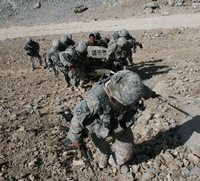LOGAR PROVINCE, Afghanistan -- The observation post near Route Georgia -- the U.S. military's codename for one of the roads running through this eastern province -- had a power problem. In the rugged, breadbasket district of Baraki Barak, 50 miles south of Kabul, there are just a few hundred* American soldiers and a similar number of Afghan security forces to provide security for tens of thousands of farmers and their families. To keep watch over the district between foot and vehicle patrols, the U.S. Army's 3rd Squadron, 71st Cavalry built observation posts atop mountain "spurs" -- ridges, essentially -- and outfitted them with sensors, weapons and radios. To keep its systems running around the clock, OP Spur on Route Georgia needed a generator.
The unit's solution to the problem of powering the observation post illustrates many of the most vexing challenges underlying the eight-year-old Afghanistan war. Poor infrastructure, daunting terrain, manpower shortages, equipment shortfalls and a sometimes ambivalent local populace dog not just 3rd Squadron, but the whole war effort.

Soldiers from 3rd Platoon, 3rd Squadron, 71st Cavalry carry a generator to
an observation post, Logar province, Afghanistan, Oct. 16, 2009 (David Axe).
Back at 3rd Squadron's Forward Operating Base, nestled beside the district government center and an apple orchard, the command staff settled on what they thought was an elegant solution. The squadron's 3rd Platoon would rendezvous with a local farmer and pay him $100 -- roughly a month's wages for most Afghans -- to use one of his donkeys for the day. The platoon would tether the donkey to a sled, pile the 300-pound generator atop the sled, and let the animal drag the machine up the 1,000-foot, 30-degree slope. At the peak, one of the platoon's mechanics, Spc. Ryan Pascual, would hook up the generator.

